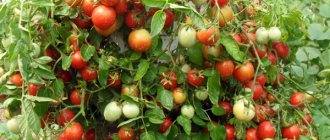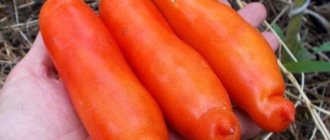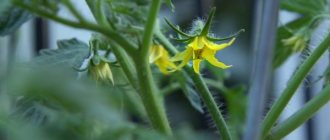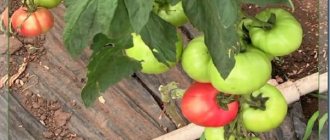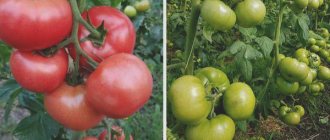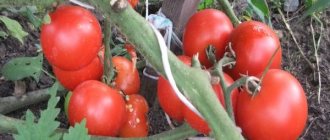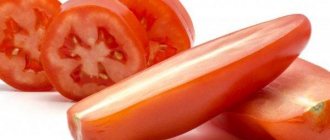Tomato Kupchikha
Description and characteristics of tomato Kupchikha F1, reviews, photos
An early-ripening, medium-sized tomato hybrid for open ground and film shelters.
The period from germination to the beginning of ripening is 90-95 days. Determinate type bush, 70-80 cm high. Does not require pinching. The leaf is large, dark green. The inflorescence is simple. There are 5-6 fruits in a cluster.
The Kupchikha hybrid is included in the State Register of the Russian Federation for cultivation in open ground and under film covers on private farms.
Basic qualities of fruits
The fruits are round and flat-round, smooth, dense, red in color at maturity, fleshy, weighing 200-250 grams, good taste for a hybrid. These tomatoes are suitable for early fresh salads, home cooking, and processing into tomato products.
The value of the hybrid : disease resistance, heat resistance, early and vigorous fruiting, excellent transportability of fruits when transported over long distances.
Tomatoes retain commercial quality for a long time on the bush and after harvesting (up to 45 days).
Features of cultivation, planting and care
Sowing seeds for seedlings is carried out 50-55 days before the intended planting in the ground. Seedlings dive at the stage of two true leaves. When planting seedlings in a permanent place per 1 sq. It is recommended to place up to 4 plants per meter of land.
Further care for tomatoes consists of timely watering, fertilizing with complex mineral fertilizer, pinching and preventive measures to protect against diseases and pests.
If you grew Kupchikha f1 tomatoes, please write whether you liked them or not. What was the yield and taste of the fruits like under your climatic conditions? How do you rate the disease resistance of this hybrid? If possible, attach a photo of your tomatoes to your comment. Thank you!
Your reviews of the Kupchikha tomato and additions to the description will help many gardeners evaluate this hybrid more objectively and decide whether it is worth planting or not.
Characteristics of varieties with similar names
The Merchant tomato belongs to the group of beef tomatoes. An early ripening variety begins to bear fruit 105-110 days after germination. The determinate bush reaches a height of 90-100 cm during the growing season.
Ripe tomatoes without a characteristic spot near the stalk. The weight of the fruit reaches 400 g. Tomatoes have fleshy pulp and contain a high concentration of dry matter. When cutting horizontally, chambers with a small number of seeds are observed.
The Kupets tomato is a mid-season semi-determinant hybrid variety that is grown mainly in any film shelters, in more rare cases - in beds. The plant produces large fruits and a large amount of harvest.
Description of the Kupchikha tomato variety, its advantages and cultivation
Every season, summer residents update their arsenal of cultivated tomato varieties with new specimens. Preference is given to undemanding and productive tomatoes. This is exactly what the Kupchikha tomato is.
Description of the variety
Kupchikha f1 is suitable for growing both in open ground and in a greenhouse. The fruits can be eaten fresh, processed, or canned.
The variety is an early ripening variety; it takes 90–95 days from the emergence of seedlings to the ripening of the first tomatoes. The height of the plant reaches 80 centimeters. Determinate bush. The leaves are large and dark green in color. One bunch can produce 5-6 tomatoes.
The fruits are smooth, round, slightly flattened. Medium density pulp. When ripe they have a rich red color. The number of seed nests is from 4 to 6. The weight of one tomato reaches 250 grams. As evidenced by numerous reviews from gardeners, the fruits have excellent taste characteristics.
In open ground, the yield per square meter is up to 17 kg of ripe tomatoes; in greenhouse conditions, this figure decreases slightly - to 15 kilograms.
The description of the variety suggests that it is characterized by increased resistance to verticillium wilt, as well as fusarium wilt.
Main advantages of the variety
Those who planted Kupchikha on their plot managed to appreciate a number of advantages inherent in this particular variety. These include:
- resistance to the most common diseases;
- resistance to high temperatures;
- possibility of getting an early harvest;
- friendly ripening of fruits;
- excellent keeping quality and transportability;
- does not require pinching.
Most of those who have tried to grow the Kupchikha tomato variety on an industrial scale noted that the crop after harvest can retain its marketability and taste for up to one and a half months.
Features of cultivation
The characteristics of the variety indicate that in order to obtain an earlier harvest, it is recommended to sow seedlings as early as March. Seeds are germinated at a temperature of 20–22 °C. During the growth process, seedlings need complex feeding, which is carried out 2-3 times. A week before it is planned to plant tomatoes in open ground, they begin to harden them.
In order to grow a good harvest from this variety, you need to choose a bed with light and fertile soil rich in nutrients. You can use places where legumes, carrots, cucumbers, onions, etc. used to grow. 3-4 bushes are placed per square meter. When fruits begin to form, it is recommended to apply complex mineral supplements. During the entire growth period, loosening and timely removal of weeds is required.
Tomatoes need stable watering, however, increased air humidity negatively affects the condition of the bushes. You should be guided by how much the top layer of soil dries out. Water the plants after sunset. It is better if the water is warm.
As a preventative measure, you can treat the soil with ash and spray the tomatoes themselves with Bordeaux mixture.
Those summer residents who personally raised the Merchant's wife were satisfied with the result. One woman said that she planted just a few bushes on the advice of a neighbor as an experiment. As a result, the harvest was enough not only for fresh salads, but also to make small preparations for the winter. In comparison with another variety that she had long cultivated at the dacha, Kupchikha turned out to be the undisputed leader and earned the right to take a place in the garden next season.
Recommendations for cultivation
Thanks to the unpretentiousness and endurance of the Kupchikha tomato, they can be successfully grown both in a summer cottage and on an industrial scale.
You can get a good harvest of this tomato variety even when grown on heavy, humus-depleted soil. According to the unspoken law of crop rotation, tomatoes are best grown in areas where cucumbers, onions, beans or carrots used to grow. No more than four tomato bushes can be planted on an area of one square meter.
https://www.youtube.com/watch?v=O3D1P75Z6ig
When fruit formation begins, the plants can be periodically fed with mineral fertilizers. To increase the productivity of the soil on which tomatoes are grown, it is necessary to weed and eliminate weeds. To ensure air exchange in the root system of the plant, it is recommended to loosen the soil from time to time.
Attention! It is not recommended to water the soil around the plant abundantly. Otherwise, when it is oversaturated with moisture, the bush begins to slow down its growth. In addition, excess moisture in the soil provokes the appearance of late blight in tomato bushes. For watering tomatoes, it is recommended to use warm water, which has been allowed to sit in a container for several days.
tomato Kupets - description and characteristics of the variety
Description of early ripe tomato Kupchikha, cultivation and care rules
The Kupchikha tomato is included in the State Register of hybrids and varieties approved for cultivation in Russia. The determinate type of bush is unpretentious both in open ground conditions and in greenhouses and greenhouses on a personal plot.
Biological and agrotechnical indicators
The variety is one of the earliest ripening tomatoes. It produces the first harvest within 3 months after germination. Since the plant reaches a height of up to 1 m, and the stem can contain several very large fruits, it should be tied to a support. Merchant f1 is a hybrid with improved storage and transportation parameters. Its predecessors had a number of disadvantages related to the impossibility of long-distance transportation. They quickly became unusable due to the low density pulp.
Today, reviews of Kupchikha are no longer so categorically negative in terms of delivery to consumers in regions remote from the place of cultivation. The plant has become more resistant to fusarium and verticillium. The pulp has reached medium density. The vegetable really lives up to the name “merchant”, as it is large in size and slightly flattened in shape with a smooth surface.
Considering the description of the variety, we can highlight the following characteristics:
- dark green color of large leaves;
- ripening period – 90-95 days;
- fruit weight – up to 400 g;
- number of tomatoes per 1 bunch – from 5 to 6 pieces;
- number of seed nests – 4-6.
A simple inflorescence forms a stalk with an articulation. Those who grew Kupchikha tomatoes in open ground under favorable summer conditions received about 16 kg of bright red fruit from an area of 1 m². In greenhouses the yield is slightly lower - 10-15 kg.
The high yield of the variety is achieved through strict adherence to the rules for preparing the seed fund. Before planting, the seeds should be germinated, maintaining a temperature range of +20...+22°C. After planting the germinated seeds in the ground, 2-3 fertilizing of the soil with organic fertilizers is carried out.
Description of fruits
“Kupets” tomatoes are round, deep red, large, juicy, and fleshy. Suitable for fresh consumption and canning.
Advantages of the variety
“Merchant” tomatoes were developed relatively recently, but have already proven themselves well and have won the approval of many gardeners. Here are the main advantages of the hybrid:
- High yield;
- Very long shelf life (up to 6 months when fresh);
- Resistance to Fusarium wilt and tobacco mosaic virus.
Earthweed "merchant's wife": description of the variety, cultivation, care
To be precise in terminology, the “merchant’s wife” strawberry is not at all the berry that summer residents are accustomed to growing, but a hybrid form, patented under the name “zemklunika”. The variety appeared thanks to the work of breeders back in the 60s in the USSR. These days, zemclunica is becoming popular again.
The history of the appearance of the hybrid "merchant's wife"
Zemklunik "Kupchikha" was obtained at the famous experimental site in the village of Kokino, Bryansk region. The authorship belongs to the famous breeder, Professor S.D. Aitzhanova, who has been working on breeding various varieties of garden strawberries for more than three decades.
The parent forms of the “merchant’s wife” are certain varieties of garden strawberries (Fragaria ananassa) and strawberries (Fragaria moschata). The main problem that breeders tried to solve was the breeding of large-fruited berries, since the strawberry-strawberry hybrids of the first generations were small-fruited and had low berry set.
Numerous photos and reviews from gardeners show that the result was excellent. The new hybrid was given the name "merchant's wife". Based on strawberries and their characteristics, an application for admission was submitted in 2014, and in 2022 the hybrid was included in the list of the State Register of the Russian Federation (see video).
On a note! Of the numerous varieties of earthen grass bred by breeders, only this one is registered in the State Register for 2019.
Along with the “Kroshka” and “Anastasia” varieties, “Kupchikha”, which has no analogues in the world, is the pride of the Kokinsky breeding stronghold.
Main characteristics
The description of the variety gives an idea of what to expect. Despite the family ties with garden strawberries, often called Victoria in everyday life, the culture is externally different from its “parent”. The bushes are medium-sized, spherical, dense. The leaf blades are slightly concave in the middle, wide, wrinkled. The leaves are strongly ribbed, the color is bright green, and there are wide, blunt teeth along the edges.
The leaf blades are supported by long, heavily pubescent petioles. The peduncles are tall, located at the same level with the leaves, and produce many large, boiling-white, untwisted flowers. The number of flower stalks on one plant is up to 12-15 pieces, each with approximately 8-10 ovaries.
The “merchant’s wife” berries deserve special attention: large in size, cylindrical in shape, similar to ruby medallions. There is a neck, the color of the skin is dark red. The color is uniform, the achenes stand out well on the surface of the berries. The lower part is comb-shaped, with “horns”.
The weight of the largest specimens is 18-20 g, on average the berries weigh 7-10 grams. The pulp is the same color as the skin, low-juicy, and has a dense structure. The taste is rich, sweet, pleasant, with a pronounced aroma of nutmeg. There is no sourness. Tasting score: 5 points out of a possible five.
II. Indeterminate varieties (unlimited growth)
These are tomatoes that will grow until they turn blue until the owner or the onset of the cold season stops them. They have great yield potential, which is more successfully realized in high greenhouses. We place approximately three bushes on 1 square. With supports such as strong trellises, open ground is not prohibited, which will be especially welcome in the southern regions.
Tomato Scarlet candles
Good for pickling, sweet. This is a patented mid-early variety (Siberian breeders distinguished themselves!). In the state register since 2007. They are characterized by a high ability to form ovaries in any conditions. From 1 sq.m you can actually get a bucket and a half. The clusters are arranged in tiers, the weight of the fruit on the lower branches reaches 120 g, on the top ones - half as much.
Very lightweight. A mid-early Siberian variety for canning whole vegetables. The fruits are elongated, reaching (maximum in our conditions) 13-14 cm in length, weighing about 120 g, and have a beautiful crimson hue. They have few seeds, are very fleshy, strong, and easy to keep. If they are picked green, they do not spoil and ripen perfectly.
The longest
A new product of Siberian selection. It begins to ripen already on the 110th (you can add a couple more) days from the sprouts appearing on the surface of the soil. Fruits have a unique length - 20 cm (specific size)! They are very elongated, with a small pear-shaped constriction in the upper part, uniformly slightly expanding downwards, with a spout. Vegetable clusters bear up to seven red fruits weighing up to 180-190 g. The product is successful in transportation, long-term storage, and pickling. Collection - at least a bucket from three plants.
High yield
The variety is productive and unpretentious. Tolerates slight shading. It ties well. Neither high nor low temperatures are scary. It succeeds in protected soil, but outdoor cultivation is not prohibited. Tomatoes begin to ripen in 106-113 days; at the same time, the plant successfully continues to grow and form clusters - up to 10 pieces per bush.
Each bears up to eight graceful fruits - cylindrical and pointed, in full ripeness - iridescent pink in color. The weight of each vegetable is 100-120 g. They contain a high percentage of sugars and dry matter. They do not burst when pickled, are good for drying, obtaining thick juice and, oddly enough in your opinion, for making tomato jam. With diligent care, the bush can bear up to a bucket of quality fruit.
Tomato Niagara
Weighty brushes
This mid-early vegetable variety has been on the state register since 2010. The bush is tall, but compact in width. It has a highly branched root system, responsive to increased nutrition and good water supply. A valuable feature of this Siberian variety is its multiple clusters, each of which bears up to 14 fruits weighing 85-115 g.
Meaty and sweet
This is one of the sweetest and meatiest products of Siberian breeders. It has been registered in the state register since 2007. The tomato is mid-season (116-118 days from the appearance of sprouts), with large foliage. The fruits resemble long, sharp peppers - they grow up to 15 cm. They are an elegant red color, the weight ranges from 120-185 g. The pulp of vegetables contains very little water and seeds. In the best case, there are up to a dozen fruits in one cluster. One bush gives 2-3 kg.
Tomato Koenigsberg
Excellent ovary
Included in the state register in 2005. The variety rightfully takes its place among the most productive Siberian varieties (up to 20 kg per square meter of land in a greenhouse). It sets perfectly even in the hot atmosphere of closed ground. Plants with a powerful bush with large leaves require increased nutrition and careful pinching.
The first ovary is formed after the growth of the 12th leaf, then inflorescences are formed every 3 leaves. Refers to varieties of medium ripening; in Siberian conditions, approximately half of the crop ripens; the rest of the fruits turn red quite well when ripened. Tomatoes in the lower clusters of vegetables weigh 300 g, and in those above - no less than 150 g. The shape is elongated, heart-shaped, smooth, and beautiful.
Vitamin and sweet
Ripe tomatoes have a golden-orange color and contain a record amount of carotene vitamins. The pulp is sweet and aromatic, like berries and fruits. The ripening period is average. The lower fruits are capable of filling up to a mass of 400-450 g, higher up the bush - 200-300 g. They are oval, often with a spout. The plants grow clusters through the leaves, each containing on average, as stated, up to 5 fruits. Productivity is high. The keeping quality is excellent. It is especially tasty when salted with gelatin.
Harvest hearts
Close internodes and a powerful trunk with dense foliage are like standard varieties, only the height is two meters. The Siberian breeding novelty produces half a bucket of fruit from one such “tree”. Ripening begins on the 115th day. Forms up to 6 beautiful clusters with 5-7 red tomatoes weighing 200-250 grams, shaped like strawberries.
Tomato Budenovka
Resistant to cracking
The variety is an improved version of Ox Heart, with a higher yield (about 9.4 kg per square), early ripening, good resistance to diseases (even to late blight) and cracking of the apical tissue of the fruit for a fleshy variety. Heart-shaped, ribbed tomatoes with excellent taste.
Record weight
The variety is a new product from a team of breeding scientists under the leadership of V.F. Gavrisha. Registered in the state register in 2015. Due to the unrealistically large fruits of vegetables, it is included in the “Russian Hero” series. The variety is not very fast in terms of ripening time (from 120 days), therefore it requires early planting of seedlings, especially careful pinching and decent feeding.
In Siberia and Central Russia it works well only in closed ground conditions, including a greenhouse. The average return from a bush is 3.6 (plus or minus) kg, the record is 7 kg. The tomatoes are flat-round, slightly ribbed, have an excellent smell and are very juicy, each weighing 400-600 g, not uncommon - 800 g. There are 2-3 tomatoes in one cluster of plants; if you leave only one tomato in it, it can pull more than 1 kg. Such “bogatyrs” are better suited for salads and distillation for juice.
Bowl of salad from one fruit
One of the best salad novelties, the yield is high. The plant bears 5-6 racemes. The fruits look very attractive due to their raspberry-pink color, large up to 500-800 g. The tomatoes are flat-round, ribbed, sweet. There is high resistance to cracking; The pulp density is average. A rare quality for large-fruited varieties: the fruits do not tend to quickly soften and spoil during storage.
According to the ripening period, the variety is classified as mid-early and mid-ripe. Perfect for preparing preparations: tomato paste, juice. This tomato variety is characterized by high yield. You can remove up to 5-6 kilograms of tomatoes from one bush.
Giant orange sweet
It has plasticity, rare for a large-fruited variety, and relative unpretentiousness. Delicate sweet pulp combines with excellent keeping quality. The tomatoes are round-flat (their “ribs” stand out a little), sunny orange in color. The average weight of a tomato is 0.5 kg, but in reality there are 1 kg of fruit on the bush.
Tomato Honey Drop
Sweet babes
Tomatoes from the “cherry” group, original in shape and color. Golden-yellow “pears” weight 30 g. Potato-type foliage, the bush of the plant is incredibly branched: stepsons strive to grow even at the ends of the flower racemes. But in the greenhouse you still need to remove the branches (at least partially), otherwise you will end up with a jungle. Vegetable clusters are multi-fruited clusters and the overall yield is very good. The fruits on the clusters below ripen 105 days after germination.
Plum sweets
A modern variety of breeders under the leadership of V.F. Gavrisha, a new product in the group of cherry tomatoes - the Monisto series. The year of entry into the state register is 2015. First harvest on the 115th day. The tomatoes are oval, weighing 25-40 g, collected in clusters of 30 pieces. The variety is the most unusual in color among tomatoes. It has fruits of a brown-burgundy hue, with a specific set of vitamins and an original taste.
Kupchikha – variety of Tomato plant
Variety characteristics:
Properties of the Kupchikha variety:
Recommended region on the map:
Information on the admission of Tomato Kupchikha from the Register of the State Variety Commission of the Russian Federation
Application for admission No. 52051, registered 2009-01-12. The Tomato Kupchikha variety was included in the register of those approved in 2010. Approved for use in regions: All regions.
The originator of the Tomato Kupchikha variety is:
- LLC AGROFIRM SEDEK (142006, MOSCOW REGION, DOMODEDOVO, VOSTRYAKOVO microdistrict, PARKOVAYA STREET, 19)
Information about the patent for the Tomato variety Kupchikha
Patent holder of the Kupchikha variety:
- LLC AGROFIRM SEDEK (142006, MOSCOW REGION, DOMODEDOVO, VOSTRYAKOVO microdistrict, PARKOVAYA STREET, 19)
Application for protection of the Kupchikha variety No. 52052, registered 2009-01-12.
Patent No. 5508, registered 2010-09-03. Estimated patent expiration date 2040-12-31.
Authors of the variety Tomato Kupchikha
- Lukyanenko Anatoly Nikitovich
- Dubinin Sergey Vladimirovich
- Dubinina Irina Nikolaevna
Other varieties of tomato plant
Search for variety by name
Variety selection
How to grow
The variety is grown from seedlings. Seeds are sown in the last days of March or in the first week of April. Before planting the seed, it is recommended to treat it using an aqueous solution of agave and a growth stimulator. Then the seeds are planted in the ground. It is necessary that the soil temperature is between 25 and 27 degrees.
You must first prepare a soil mixture, including the following components:
- peat;
- sand;
- wood sawdust;
- lime;
- charcoal, which must first be crushed.
When seedlings are planted in the ground, you need to ensure that there are no more than four bushes per square meter. Before planting seedlings, you need to water the soil with dissolved potassium humate.
It is recommended to care for a hybrid variety in the following way:
- Water regularly with warm water.
- Loosen the soil.
- Use mineral fertilizer.
- Maintain low air humidity (for this, watering the bushes should be carried out in the evening hours - after the sun has set).
- Remove weeds.
Care
At the beginning of the season, strawberries are fed with complete mineral fertilizer, including nitrogen, phosphorus and potassium. Per 1 m2 they give 20-25 g of fat. Before flowering, spray against strawberry mite with Fufanon. The soil is loosened and weeded, watered and covered with mulch before flowering. The second watering of strawberries is carried out after flowering and formation of ovaries. Subsequent waterings are given strictly as needed if the weather is dry and hot.
After 5-7 days from the last harvest, the tops of the Kupchikha variety are mowed. The leaves are not completely removed with pruning shears; a rosette of 3-5 young leaves is left. Old tops along with mulch must be removed from the plantation; pathogens and pests can remain in them. The soil is shed with a pink solution of potassium permanganate. Then they give complete fertilizer. Good results in shoot regrowth were shown by bushes injected with Reasil complex fertilizer after mowing.
Until the end of the season, strawberries continue to be watered, loosened and weeded. Before winter shelter, they replenish the organic matter consumed during the summer. If the rows are covered with agrotextiles, they are raised and 1.5-2 buckets of compost or rotted manure are added to each linear meter of the row.
Loss of Kupchikha bushes is also observed during periods of ice crust and stagnant water in early spring. To avoid these negative phenomena, planting on agrotextiles or high ridges should be used. Every year it is necessary to establish small new plantations of the Kupchikha variety, providing a reserve of plants for replanting on the existing areas.
Productivity
The shape of tomatoes of the Kupets variety is round. The fruits are smooth and large. The pulp is dense, juicy and meaty. The color of an unripe tomato is light green. When a tomato ripens, its color turns deep red. When cut horizontally, you can see that the fruit contains four or more chambers with grains.
Tomatoes reach a weight of up to 114-150 grams. The variety produces a large amount of harvest - from 11 to 14 kilograms of tomatoes can be harvested from one square meter. If you grow the plant in heated industrial glass greenhouses, the yield increases to 40-45 kilograms of tomatoes per square meter.
Kupets tomatoes are used in many areas of cooking. They are consumed fresh, prepared into salads, and preserved for the winter.
The marketable yield is 8 kg per 1 sq. m. In winter greenhouses with extended rotation, more than 30 kg can be obtained from a similar area.
